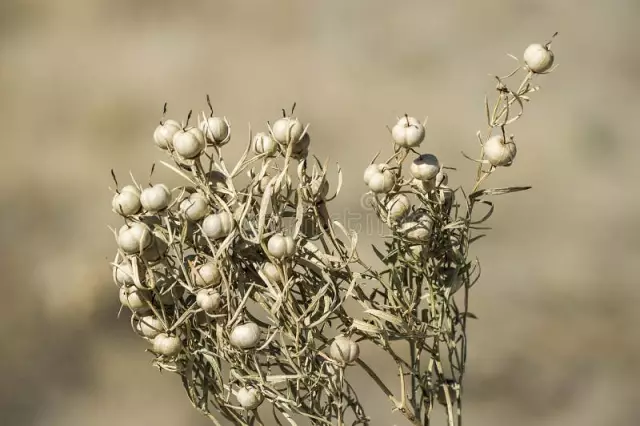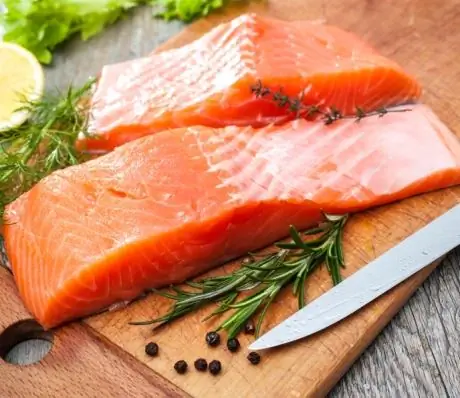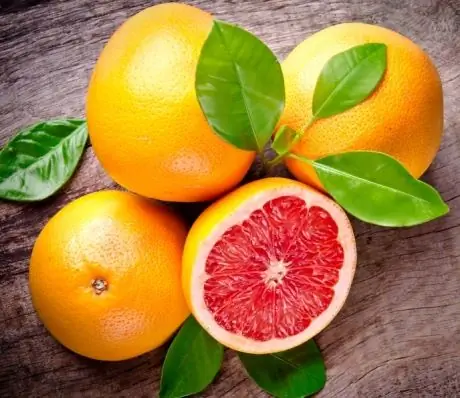- Author Rachel Wainwright [email protected].
- Public 2023-12-15 07:39.
- Last modified 2025-11-02 20:14.
Garmala
Instructions for use:
- 1. Chemical composition
- 2. Useful properties
- 3. Indications for use
- 4. Contraindications
- 5. Home remedies

Garmala (synonyms: burial ground, grave grass, carpenter, arrow, white-sided, rue, yuzyurlyun, yuzerlik, pigan, isirik) is a perennial herbaceous poisonous plant of the Selitryankovye family, widely used for medical purposes.
Description of the plant: multiple stems lignified with age up to 50-65 cm in height; bare, twisting, green branches; alternately sessile, palm-shaped leaves dissected into several segments; numerous white or pale yellow flowers, 2-3 on the tops of mature stems and young branches, with calyx dissected into 5 linear sepals; the corolla consists of 5 petals with 10-15 stamens.
Harmala is found in the Caucasus, in the southern regions of the European part of Russia, Western Siberia, Ukraine, Mongolia and Central Asia. It grows on sands, saline clay soils, in steppes and semi-deserts. Often the plant grows as a weed in vineyards, melons, alfalfa and cereals, on the sandy shores of lakes and rivers, along roads.
Chemical composition
All parts of grave grass contain many beneficial ingredients. The plant contains the following biologically active substances: carotenoids, steroids, saponins, proteins, fatty oil, organic acids, a significant amount of alkaloids (beta-carbolines): harmine (banisterol), peganin (vazicin), harmaline (harmidine), peganidine, deoxypeganin, harman, pegamine, dipegin, peganol, vazicinone, quinaldine, deoxyvazicinone, harmalol, quinoline, etc.
Stems, leaves and flowers are rich in zinc, iron, potassium, magnesium, strontium in high concentrations, as well as trace elements such as aluminum, manganese, copper, nickel, chromium, lead.
The roots contain up to 2.7% alkaloids.
The seeds contain up to 14.2% fatty oil, dyes.
Beneficial features
Due to alkaloids harmala has a muscle relaxant effect on smooth and striated muscles.
The plant contains a large amount of the alkaloid harmaline, which has an exciting effect on the central nervous system, in particular on the motor centers of the cerebral cortex. Harmaline has an abortive property, since it stimulates the contraction of the uterine muscles. The alkaloid expands the peripheral vessels, thereby lowering blood pressure, calming the rhythm of the heart muscle, and relaxing the muscles of various organs. At medium to high doses, harmaline is toxic and can be fatal.
The alkaloids harmine and peganin increase blood pressure, help to relax the muscles of the heart, intestines and uterus. Garmin is less toxic than peganin but can cause seizures in high doses. It is also used as an antidepressant. Garmin has the ability to expand the psychic hyper-subtle perception of the world. According to some sources, the greats Michelangelo and Leonardo da Vinci used harmala to develop their creative vision.
The alkaloid peganidin has a pronounced bactericidal property and anti-staphylococcal activity.
Peganin relaxes the bronchial wall, therefore it is used for bronchial asthma.
Several alkaloids are effective in combating cocaine and heroin addiction.
Some harmala-based drugs have a sedative, anti-inflammatory, analgesic, diuretic, diaphoretic effect
Indications for use
In the Russian Pharmacopoeia harmala and preparations from it are not included, the medicinal properties of the plant are under study.
In African and Asian countries, as well as in some European countries, harmala raw materials are used to treat diseases of the peripheral nervous system (neuritis, mononeuritis and polyneuritis). From the alkaloids of the quinazoline group contained in the plant, deoxypeganine hydrochloride is obtained - a substance with a reversible anticholinesterase effect, which increases smooth muscle tone and restores neuromuscular conductivity. This remedy is used for hemiplegia, myopathic conditions, myasthenia gravis, myopathy, lesions of the anterior horns of the spinal cord, hemiparesis, and also as a laxative for intestinal atony of various origins and chronic constipation.
The alkaloids harmine and peganin are effective in certain diseases of the central nervous system, such as Parkinson's disease, tremors, and the consequences of epidemic brain inflammation.
The harmala alkaloids are able to resist cocaine and heroin addiction. In some clinics, the burial is used as part of the treatment of alcohol and nicotine addiction.
Plant-based products have analgesic, sedative, diuretic, diaphoretic and anti-inflammatory effects.
In the traditional medicine of Asian countries, roots, young stems, leaves and flowers are used. Decoctions and infusions are used for diseases of the gastrointestinal tract, measles, malaria, fever, colds, for gargling - for diseases of the gums and throat.
In Uzbekistan, grave grass is used as a disinfectant during flu epidemics by fumigating a room with smoke. Leaves are brewed for depression and neurasthenia, periodontal disease and kidney disease.
In Afghanistan, paralysis is treated with smoke from plant raw materials, poultices and compresses to tumors are made from leaves.
The seeds of the burial ground have antiseptic properties. In India they are set on fire and the wounds are fumigated with smoke.
A decoction of seeds is effective for bronchial asthma. It is also drunk as a diaphoretic and diuretic, used to treat helminthiasis, diseases of the gastrointestinal tract.
In the Caucasus, fresh harmala juice is used to treat early cataracts. Pounded grass mixed with fennel juice, honey, wine and chicken bile is recommended for visual impairment.
A strong decoction of the herb has tranquilizing properties.
Baths with the addition of harmala decoction relieve inflammation and pain in rheumatism, are effective for scabies, dermatitis and other skin diseases.
Contraindications
- hyperkinesis associated with overexcitation of the motor centers of the cerebral cortex;
- pregnancy;
- lactation period;
- hypersensitivity.
Harmala is a poisonous plant! The use of drugs based on it requires special care and the strictest adherence to the dosage regimens recommended by the doctor.
If the treatment regimens are not followed, the herb can cause hallucinations, drowsiness, tachycardia, convulsions, depression, and a decrease in body temperature. Prolonged treatment with a burial ground may result in increased urination, difficulty in breathing, and impaired functionality of the gastrointestinal tract.
If the dose is significantly exceeded, convulsions, tremors, paralysis of the musculoskeletal system may occur, which can lead to death.
Home remedies from harmala
- infusion used for colds, rheumatism, myasthenia gravis, myopathy, syphilis: 1 tbsp. l. dry herbs pour 1 cup boiling water, insist and strain for 1 hour. Take: for colds - 20 minutes before meals, 1 tbsp. l. 2-3 times a day; for myasthenia gravis, myopathy and rheumatism - 10-50 ml 3 times a day, regardless of food, starting treatment with a minimum dose (1-2 tbsp. l.); with syphilis - 2-5 tbsp. l. 2-3 times a day, also starting treatment with a minimum dose;
- decoction for the treatment of gum disease: 1 tsp. Pour 1 cup boiling water over chopped dry grass, insist on a steam bath in a sealed container for 30 minutes, suck a little and strain. Rinse your mouth with this tool;
- extract used for myasthenia gravis, torsion dystonia, the consequences of epidemic encephalitis, catatonic schizophrenia: pour the dried raw material with 96% alcohol in a 1: 1 ratio, insist and strain for 3 weeks. Take 6-12 drops 3 times a day;
- means for the treatment of diseases of the gastrointestinal tract, choleretic and anthelmintic agent: take 10 seeds per day with water. The effect occurs in 3-4 days;
- a decoction used for rheumatism, shortness of breath and asthma, as well as a sedative, diaphoretic, diuretic and choleretic agent: mix harmala seeds with flax seeds in a ratio of 1: 3, 1 tsp. pour the mixture with a glass of boiling water, cover with a lid and insist on a steam bath for 30 minutes, cool a little and strain. Take 1 tbsp. l. 30 minutes before meals 3-4 times a day;
- baths for the treatment of rheumatism, scabies and skin diseases due to metabolic disorders: pour 100 g of grass with 5 liters of boiling water, cover with a lid, boil for 15-20 minutes, then insist for 2 hours, strain and pour into the bath (with a water temperature of 35-40 ° C). Take a bath for 10-15 minutes every 2 days. The course of treatment is 10 baths.
Information about the drug is generalized, provided for informational purposes only and does not replace the official instructions. Self-medication is hazardous to health!






